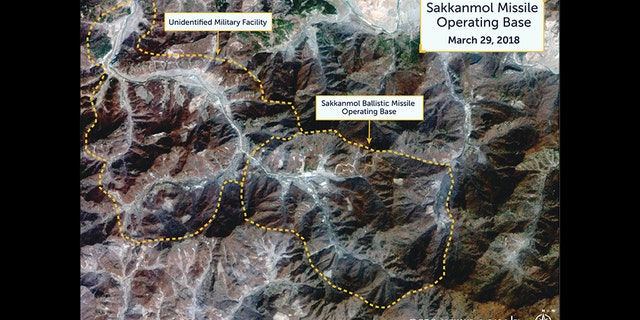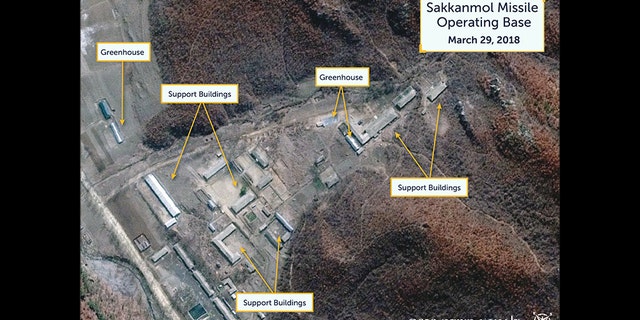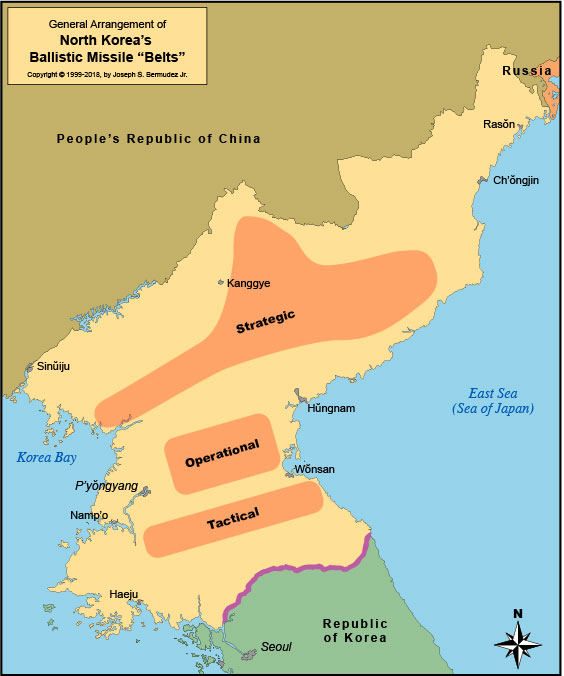
Photos by Beyond parallel/CSIS show possible missile operating bases in North Korea

The satellite image of the base in Sakkanmol, just shy of 50 miles north of the DMZ, show support facilities
Posted on 11/12/2018 8:38:40 AM PST by ETL
North Korea is conning the United States, building up secret, smaller missile bases even after publicly touting the dismantling of its main launch site, according to a new review of satellite images by a top think tank.
Citing new satellite pictures, the Center for Strategic and International Studies’ Beyond Parallel program identified what appears to be missile operating bases that have never been acknowledged by North Korean officials. CSIS' conclusions were not immediately independently confirmed.
The report identified about 15 to 20 bases being operated by the Korean People’s Army's Strategic Force, based on information from officials in the government, defense and intelligence, as well as North Korean defectors.
“The ballistic missile operating bases are small, dispersed throughout the nation, and, with few exceptions, located in narrow mountain valleys,” the CSIS report stated. “The deployment pattern has evolved over time, garnering a variety of descriptions, but today it is most commonly described as consisting of the three ‘belts’: the Tactical (or Forward), the Operational, and the Strategic (or Strategic Rear) based upon their physical distance from the DMZ [Demilitarized Zone].”
The sites can build a slew of missiles for the regime, including intercontinental ballistic missiles that may have the ability to reach U.S. territory. Though the bases are not considered traditional launch facilities, missiles can be launched from the locations in an emergency, the report stated.
Satellite images of a possible base in Sakkanmol, about 50 miles from the Demilitarized Zone, allegedly show headquarter buildings, barracks, maintenance depots and entrances to alleged underground tunnels that would hide missiles and transport trucks.
(Excerpt) Read more at foxnews.com ...


The satellite image of the base in Sakkanmol, just shy of 50 miles north of the DMZ, show support facilities
________________________________________________________________________________
May 17, 2017
http://www.dw.com/en/russia-steps-up-north-korea-support-to-constrain-us/a-38867861
__________________________________________________________
Sept 5, 2017
The US said on Monday it would table a new UN resolution on tougher sanctions in the wake of the latest test of a nuclear bomb by the North on Sunday.
Mr Putin also said that the ramping up of “military hysteria” could lead to global catastrophe.
He said diplomacy was the only answer.
China, the North’s main ally, has also called for a return to negotiations. ...”
Deep State fear porn. in fact they have dismantled 22 check points along the dmz.....things are going fine according to Trump. I believe Trump.
In other news, North Korea has recently landed a manned expedition on Mars... A further indication that we are being bamboozled again...
Joseph S. Bermudez Jr.
Joseph S. Bermudez Jr. is an internationally recognized analyst, award winning author and lecturer on North Korean defense and intelligence affairs and ballistic missile development in the Third World.
He is concurrently Founder and CEO of KPA Associates, LLC; senior imagery analyst for 38 North at Johns Hopkins SAIS; senior advisor and imagery analyst for the Committee for Human Rights in North Korea (HRNK); Satellite imagery analyst and advisor to the Korea Chair at the Center for Strategic and international Security (CSIS) and senior analyst, consultant and author for IHS Markit (formerly the Jane’s Information Group); the publisher and editor of KPA Journal; and other related positions. Previously, has served as: Chief Analytics Officer and co-founder of AllSource Analysis, Inc., and senior all-source analyst and senior manager for DigitalGlobe’s Analysis Center.
He has authored four books and more than 300 articles, reports and monographs on numerous defense-related subjects. His books: Shield of the Great Leader: The Armed Forces of North Korea and North Korean Special Forces—2nd Edition are considered by many to be the definitive “open source” works on their subjects and have been translated into Korean and Japanese. His forthcoming books Armed Forces of North Korea- 2nd Edition, North Korean Special Forces 3rd Edition and North Korean Intelligence 1945-1980, promise to follow in this tradition.
Mr. Bermudez has consulted and lectured extensively in government and academic environments both in the U.S. (e.g., National Defense University, Columbia University, Federal Bureau of Investigation, Los Alamos National Laboratories, Stanford University, U.S. Marine Corps University, U.S. Army Intelligence, U.S. Naval Intelligence, U.S. Navy Postgraduate School, etc.) and internationally (e.g., United Nations, Israel Defense Forces, International Institute for Strategic Studies, Republic of Korea National Defense College, etc.).
He has also testified before the United Nations and U.S. Congress as a subject matter expert concerning North Korea’s ballistic missile and nuclear, chemical and biological warfare programs, satellite imagery analysis of North Korean political prisoner camps and ballistic missile development in the Third World.
http://www.kpajournal.com/about/
While a considerable body of open-source information is available concerning the development of North Korea’s individual missile systems, much less is available concerning the number, deployment, and organization of the Korean People’s Army (KPA) ballistic missile operating bases. The vast majority of the information that is available tends to be internally inconsistent, incomplete, confusing, or simply incorrect.
Media reporting and defector statements have identified in excess of 65 areas or locations as ballistic missile operating bases. While there remains significant uncertainty as to whether all missile operating bases have been identified within the open-source, this number is obviously incorrect and largely a result of inaccurate and frequently internally inconsistent media reporting and defector statements; circular verification; errors in incorrectly identifying surface-to-air missile, coastal defense cruise missile, and rocket launcher bases as ballistic missile bases; use of generalized (e.g., province, county, or nearby city names) and often different location information (e.g., two different counties) for the same facility; challenges in transliterating location data; and difficulty in disambiguating place names.
Compounding these challenges is the fact that the KPA engages in an aggressive camouflage, concealment, and deception (CCD) program with regard to its ballistic missile force, the construction of new missile facilities and abandonment of others, and has at times redeployed ballistic missile units to different bases. Added to this is the confusion in distinguishing among brigade-, regiment-, and battalion-sized units. After extensive research, including interviews with North Korean defectors and government, defense, and intelligence officials around the world, many of these issues have been addressed and it appears that the KPA currently has approximately 15-20 missile operating bases.
Missile operating bases are permanent facilities that contain a unit’s headquarters, barracks, housing, support, maintenance, and storage facilities. Due to cultural factors and a military policy that states the North remains in a state of war, the majority of KPA missile operating bases display a number of distinct characteristics, including:
There has been occasional, and often sensationalist, media reporting based primarily upon defector reports that the KPA has constructed “underground launch pads,” silo-based or semi-enclosed (e.g., false mountainsides that split open) ballistic missile launch facilities in the northern reaches of the nation. However, no such facilities have been confirmed in open-source or satellite imagery to date.1
Construction of missile operating bases can be traced back to the mid-1960s and the acquisition of the FROG (Free Rocket Over Ground) series of long-range artillery rockets and the establishment of operating bases around Pyongyang and in North Pyongan province. With production of the Hwasong-5 (R-17E Scud) short-range ballistic missiles (SRBM) beginning in 1986, North Korea based these systems in the Pyongyang area and North Pyongan province.
Subsequently, as the number of available Hwasong-5 missiles and their associated TELs and new MELs slowly increased, a Scud regiment was established and deployed south of Pyongyang in 1988.2 Accompanying this, and extending into the early 1990s, the KPA initiated the construction of dedicated missile operating bases in North Hwanghae and Kangwon provinces along the demilitarized zone (DMZ).3
Some of these and later bases were created by converting existing military facilities to accommodate the ballistic missile units and their equipment. With the introduction of the Hwasong-6 (Scud C), the KPA both reorganized and expanded Scud missile units and established new units.4 By the mid-1990s, construction of additional missile operating bases was begun within South Pyongan, North Pyongan, Chagang, Ryanggang, and South Hamgyong provinces to house units equipped with the newer Hwasong-7 (Nodong) and Hwasong-9 (Scud-ER) families of medium-range ballistic missiles (MRBM).5 Construction of missile operating bases continued into the early 2000s. Since that time, there has been minor but continued development at existing bases and the construction of at least one additional missile operating base to house newer or longer-range ballistic missiles (e.g., Hwasong-11/-12/-13/-14).6
Following Kim Jong-un’s ascension to power in December 2011, he instituted widespread changes throughout the KPA emphasizing realistic training and increased operational readiness. These changes soon resulted in the reorganization of the Strategic Rocket Command into the Strategic Force during 2013 as well as significant infrastructure developments at a number of missile operating bases.
The ballistic missile operating bases are small, dispersed throughout the nation, and, with few exceptions, located in narrow mountain valleys. The deployment pattern has evolved over time, garnering a variety of descriptions, but today it is most commonly described as consisting of the three “belts”: the Tactical (or Forward), the Operational, and the Strategic (or Strategic Rear) based upon their physical distance from the DMZ.7
 General Arrangement of North Korea’s Ballistic Missile “Belts.”
General Arrangement of North Korea’s Ballistic Missile “Belts.”
The Tactical Belt extends across North Hwanghae and Kangwon provinces and is 50-90 km north of the DMZ. Missile operating bases situated within the Tactical Belt are reportedly equipped with the Scud family of SRBMs—perhaps with a small number of Nodong MRBMs. The locations chosen for these bases are far enough forward to provide coverage of critical facilities in the northern two-thirds of South Korea, yet far enough from the DMZ to be beyond the range of South Korean and U.S. long-range artillery.8 The fielding of the longer-ranged Hwasong-6 and Hwasong-9 (Scud-ER) placed the entirety of South Korea (including the island of Cheju-do) within range of these forward bases.9
The Operational Belt extends across the mountainous sections of South Pyongan province and the southern section of South Hamgyong province and is 90-150 km north of the DMZ. This belt is reportedly equipped with Nodong missiles or longer-range systems that cover all of South Korea and Japan. The Strategic Belt extends across the mountainous sections of North Pyongan, Chagang, Ryanggang, and the northern section of South Hamgyong province and is more than 150 km north of the DMZ. The units deployed in this zone were initially equipped with Nodong missiles. However, reports often claim that the Taepodong 1 MRBM and Taepodong 2 ICBM were also deployed here.10 These bases will likely house the newer Hwasong-11/-12/-13/-14 as they become deployed.
The official designations for any of the missile operating bases, or the units deployed at them, are unknown. They are, however, reportedly assigned cover designations (military unit cover designator—MUCD in U.S. and South Korean terminology) such as the “Fourth Training Center” or “Fifth Training Center.”11
The deployment pattern of the KPA’s ballistic missile operating bases is logical for a nation that still believes it is in a state of war and must be ready to defend itself from outside aggression at any time. It is also a recognition of the fact that the Korean People’s Air and Anti-air Force (KPAF) will be unable to deter a combined South Korean and U.S. air and missile offensive against the nation. The dispersed nature, small size of operating bases, and tactics and doctrine employed by ballistic missile units provide the best chances for their survival given the KPA’s technology and capabilities.
From the little open-source information available on the subject, a preliminary pattern of KPA wartime ballistic missile operations can be pieced together. If hostilities resume with little or no warning, a TEL or MEL will move out of its UGF to the base’s drive-through arming and fueling facility. Here, a missile will be loaded—if one isn’t already—armed, fueled and system checks will be conducted. The launcher will then move a short distance within the base, launch at pre-assigned targets, and return to its UGF or disperse to a pre-arranged location—potentially to a UGF away from the base.
If, however, a new conflict is anticipated, prior to the start of hostilities, the missile unit and technical support elements will deploy from the base. The TELs or MELs will move out from their UGF to the base’s drive-through servicing (e.g., arming, fueling, and maintenance) facility and then disperse to another UGF or to a network of pre-surveyed launch sites throughout their area of responsibility—often no more than a wide spot in a road. Here, they will then wait for orders to launch.
Once they launch, the TELs or MELs will quickly displace to another pre-surveyed launch position or UGF (other than those at the missile operating base) where they will meet up with the technical support element and its equipment (i.e., reload missiles, warheads, fuel, crane vehicles, etc.). Once serviced and rearmed, the technical support elements will move to another prearranged location while the TEL or MEL will either wait for a launch order or move to another pre-surveyed launch position and wait there for a launch order.
As the conflict develops, rather than returning to an operating base—which will undoubtedly be the target of repeated attacks—both the technical support element and launchers will remain in the field using pre-positioned reloads and supplies while moving frequently to different pre-surveyed locations. The missile operating base, or more likely a preplanned dispersal UGF, will function as a technical support base with technical support elements and launchers infrequently returning.
These dispersed mode operating procedures concede the absence of air superiority, minimize the loss of the technical support element, and address the reality that a single TEL or MEL with a liquid fuel missile requires approximately 30 minutes from arrival at a pre-surveyed position to prepare, launch, and begin redeployment—a long time on the modern battlefield for a highly visible target. The loss of a single launcher, while significant, does not adversely impact the overall ability of the surviving elements of the unit to conduct combat operations. However, due to its essential role in the larger organization, the destruction or neutralization of the technical support element would severely impact the ability of the parent unit to conduct launch operations. Therefore, additional procedures are in place to facilitate its survival.
This report is based upon an ongoing study of the Korean People’s Army ballistic missile infrastructure begun by one of the authors (Joseph Bermudez) in 1985, which itself is based upon numerous interviews with North Korean defectors and government, defense, and intelligence officials around the world. While some of the information used in the preparation of this study may eventually prove to be incomplete or incorrect, it is hoped that it provides a new and unique open-source look into the subject that other can build on. The information presented here supersedes or updates previous works by J. Bermudez on these subjects.
https://beyondparallel.csis.org/north-koreas-undeclared-missile-operating-bases/

I’ve never of them or him before this. Not sure what to make of it.
AND, these alleged missile operating bases are not along the DMZ. They would be fools to discard ALL their defenses, even after any 'unification'.
A UNITED KOREA is going to need 'defensive' positions in both the North and South.
Disclaimer: Opinions posted on Free Republic are those of the individual posters and do not necessarily represent the opinion of Free Republic or its management. All materials posted herein are protected by copyright law and the exemption for fair use of copyrighted works.